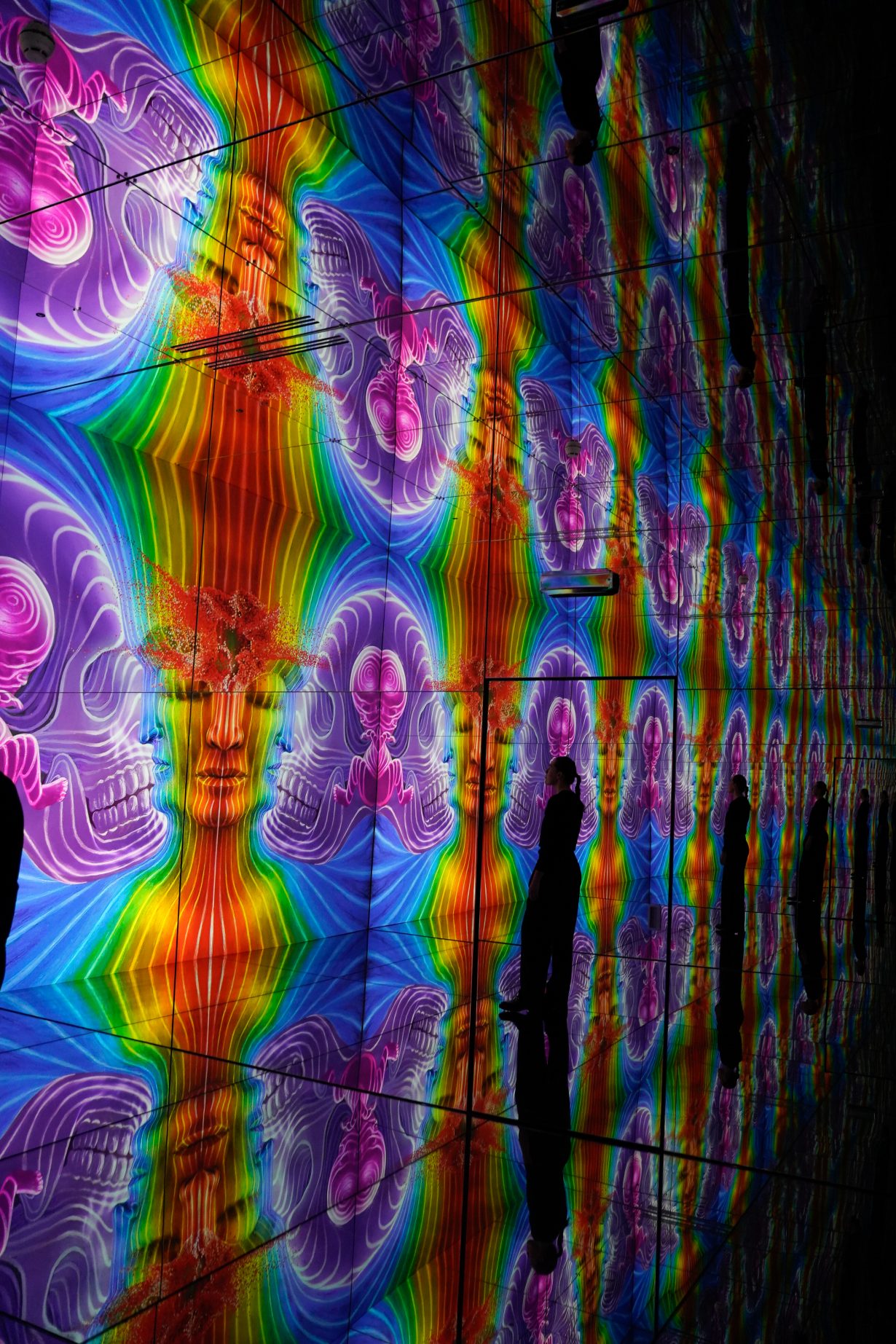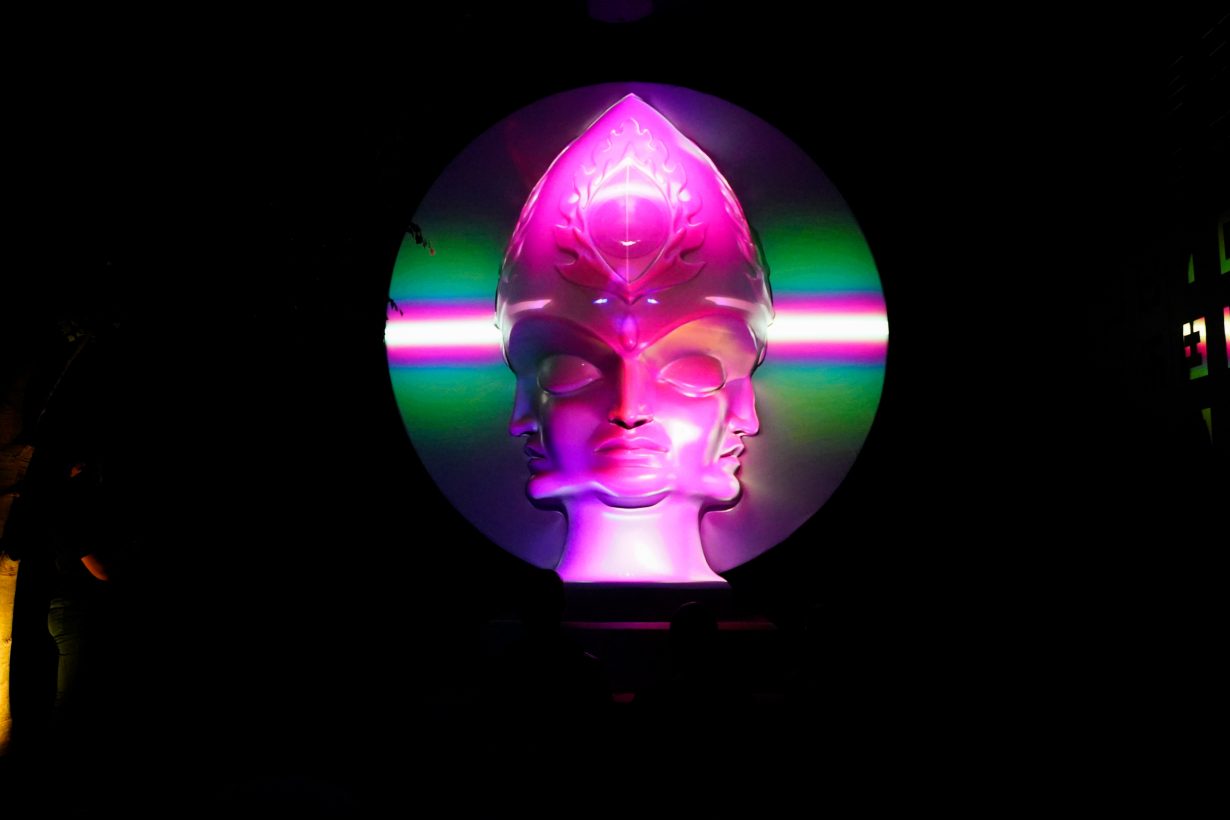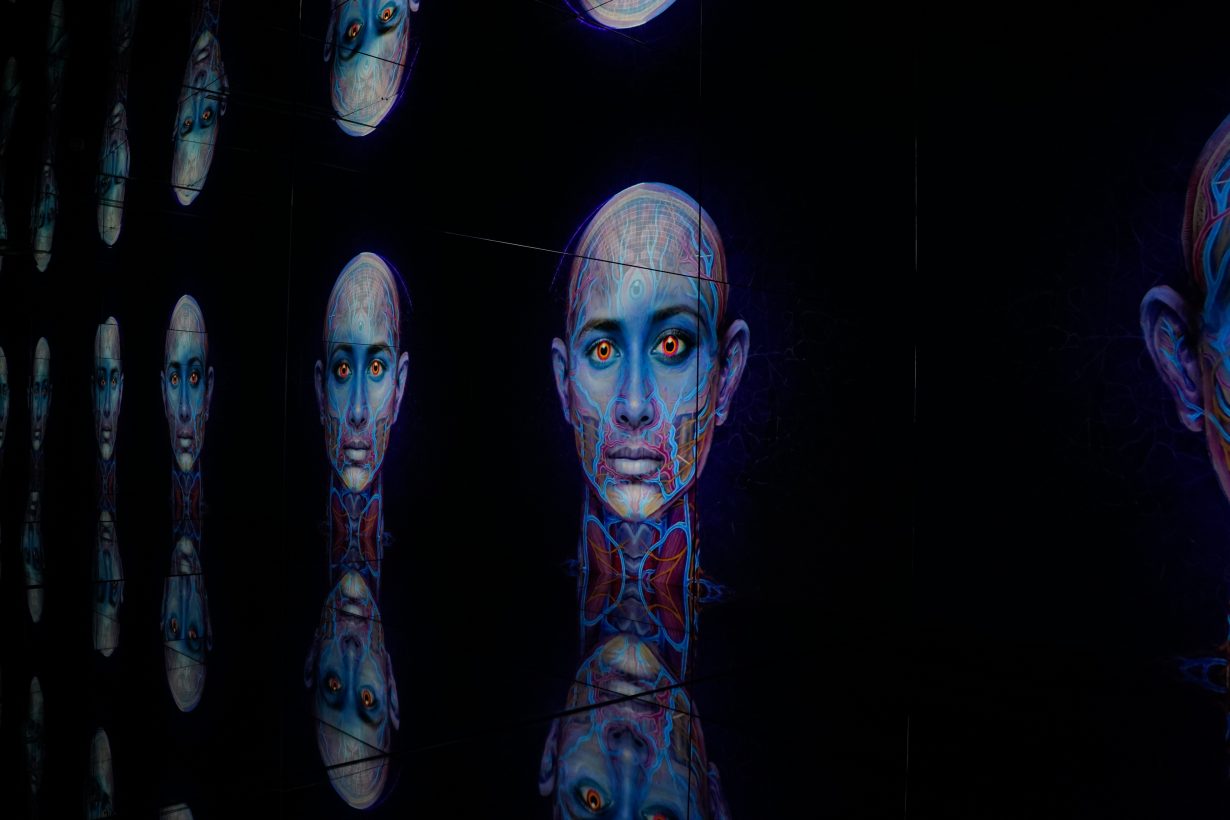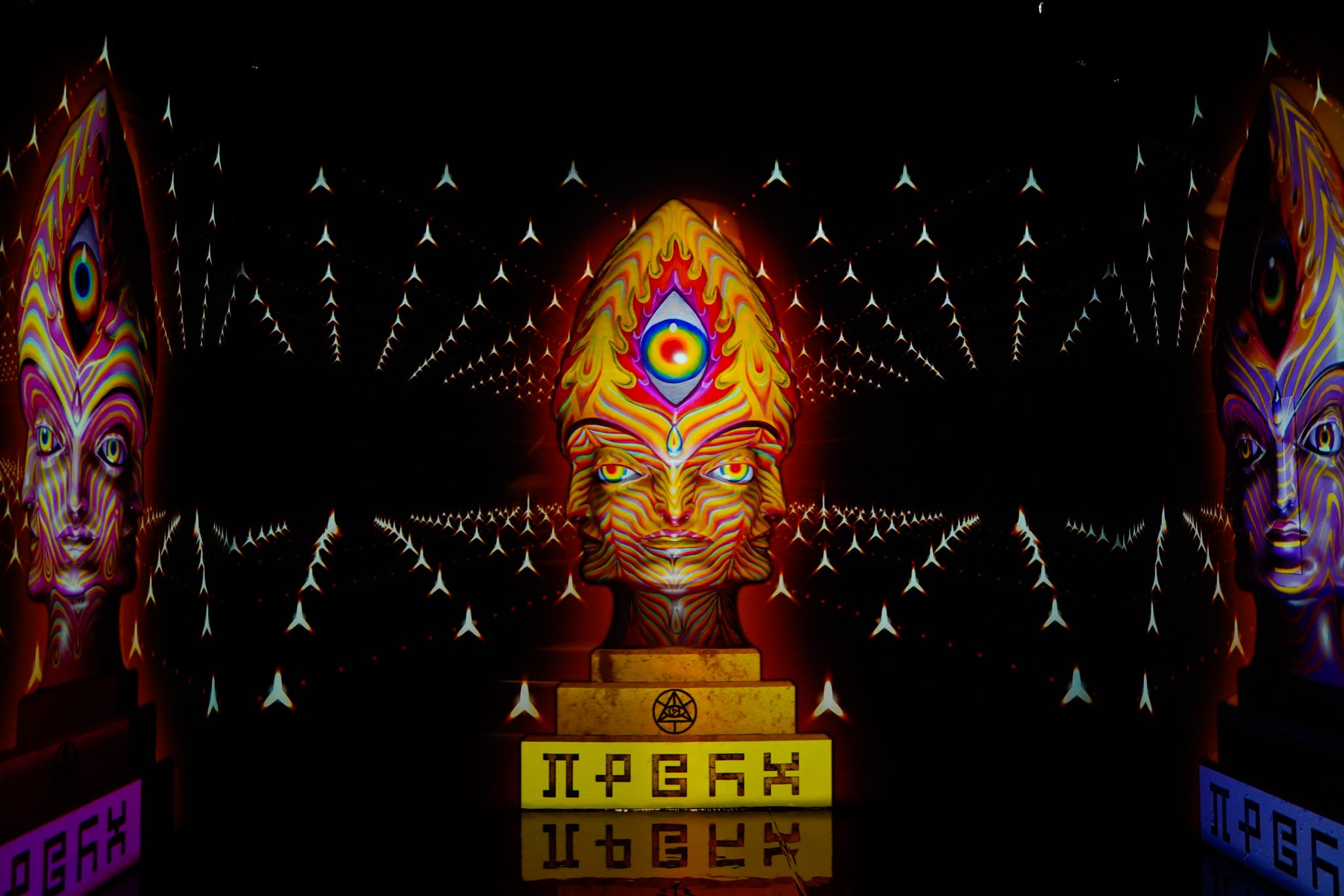The real object of these shows is you
I haven’t actually taken DMT, the potent psychedelic molecule found in ayahuasca and said to mimic near-death experiences, but I have been to Crossrail Place. It was not good. There I was in early spring: overcaffeinated, underslept and trapped in Canary Wharf’s Blade Runner complex of skyscrapers, investment firms and novelty food trucks, unable to find my way out. So it was with some trepidation that I recently returned in search of Illusionaries, an ‘experiential art hub nestled in London’s vibrant core’. If by London’s vibrant core they mean the second floor of a shopping centre, well then, yes, here we are.
Launched over a year ago, Illusionaries is one of numerous ‘immersive’ art galleries now ubiquitous in the commercial interzones of major capital cities. The term ‘immersive’ has become marketing-speak, but now largely refers to projection-based exhibits that are heavily reliant on digital technologies like projection mapping, virtual and augmented reality, CGI and surround sound, and which promise to dissolve the boundaries between artwork and audience. The immersive installation is a pretty broad, secular church, encompassing site-specific new media work by contemporary digital artists and collectives like the Japanese group TeamLab and blockbuster animated retrospectives of Masters living or dead, with the odd Instagram-centric balloon museum thrown in for good measure. ‘Immersion’ is often approached quite literally, by bringing audiences ‘into’ the art through their submersion in spectacular, digital displays of sound and image. This is not a new idea, of course – from early cave art and sacred ritual to panoramas, magic lantern projections, light shows and expanded cinema, art has found many tactics to confound spectator-artwork relations – though this contemporary iteration notably trades on viewing itself as pioneering.
Illusionaries’s third exhibition, Entheon: A Sanctuary of Visionary Art, is billed as a groundbreaking exploration of ‘consciousness, perception and the human spirit’. While there are no original artworks actually on show, another common trope of the ‘immersive’ installation, the kaleidoscopic bath of images cycles through works by American contemporary psychedelic artists Alex and Allyson Grey. Fans of the postmetal band TOOL will be familiar with their brand of anatomical psychedelia, as will anyone who has leafed through a couple of spines in a New Age bookshop. Their work has garnered a large and passionate fan base and I’m not here to debate its aesthetic value; watch Alex Grey’s charming ‘Cosmic creativity’ TED talk and you’ll get the gist.

As soon as you’ve entered through the futuristic silver doors, cracked a CBD tinny (purchasable at reception) and navigated the mirrored corridor studded with giant Egyptian heads, you’re pretty much ready to ‘fathom hell and soar angelic’. That is, if you can actually get into the rooms – who knew the doors of perception would be so hard to open? Once in, you are met with acid-colour projections of ever-shifting fractals and molecular form constants, religious and spiritual iconography (‘explore the creator within’), and snaking hieroglyphs from Allyson Grey’s Secret Writing, a 20-character alphabet that came to her during an acid trip during the early 1970s. Dazzling and outrageously gaudy anatomical drawings depicting stages of life and ego-death (including a wildly triggering image of a baby’s head crowning from a giant, neon-pink vagina) unfurl in a mirrored chamber whose most obvious precedent is Yayoi Kusama’s Infinity Mirror Rooms, first staged in 1965. And like in Kusama’s wildly popular installations, your image is reflected back in endless mirrored configurations, including on someone else’s camera phone. It is impossible to self-obliterate in these conditions.
Illusionaries claims that it is focused on creating ‘carefully selected experiences’ rather than ‘adapting existing paintings’. Except that most of these works are digital reproductions of oil and acrylic paintings. In 1985, after taking MDMA for the first time, the Greys set about creating their Sacred Mirrors series of 21 lifesize paintings of the human body and its psychic and spiritual channels of energy. You can view these works in situ at the Chapel of Sacred Mirrors, their nondenominational church in Upstate New York funded by independent donors, including soap heir David Bronner.

In the third room, I walk gingerly across a gravel floor in a tranquil garden, sprawl on a bean bag and disassociate in front of Steeple Head, a four-metre 3D sculpture of a giant head that forms the canvas for an ongoing spiritual son-et-lumière of geometric shapes and religious figures. Lulled by the steady flow of moving images and a heady soundscape of ambient trance, I am less conscious of technique, material or meaning than I am with the overall architecture of the show, and my place within it. I take pictures on my phone, reminded of Kyle Chayka’s definition of ‘ambient television’. Building on Brian Eno’s coinage of the term ‘ambient music’ on the 1978 sleeve notes to Ambient 1: Music for Airports, Chayka employs ambience to describe the distracted flow of experience watching the Netflix show Emily in Paris (2020) – which, incidentally, has been credited with inspiring an upsurge in immersive shows because of its prominent scene in Atelier des Lumières. Slow, soothing and ‘too predetermined to be dramatic’, this comfortably numbing experience offers just enough impetus to entertain you but is easily disengaged from as you jump back into other tech.
If what I’m looking at, then, is not the painting itself, but an animated projection of the painting, easily replicated in any number of other venues (these shows almost always travel), then what precisely are these environments trading in? It’s something that Entheon, with its New Age gloss of spiritual contemplation and vague appeal to therapeutic self-discovery, is more honest about than most. The real object of these shows, I begin to realise, is you.
Independently backed, immersive digital art galleries are funded through ticket sales rather than the sales of individual works and are heavily reliant on social media for their marketing. Actively designed to be shared online, these spaces turn visitors into ‘micro-influencers and brand ambassadors’, as art historian Kate Mondloch pointed out in her article on Van Gogh: The Immersive Experience (2017–). Often framed as accessible because of their participatory and interactive elements, the cost of these timed-entry shows is almost always prohibitively expensive (expect to pay £20–30 for 40 minutes). At Entheon, under-twelves are not allowed, which, though not exactly a welcoming gesture, is, in the face of the psychedelic cadavers on show, probably wise.

The obvious popularity of immersive art points to wider consumption trends: this is at once the much-documented desire for ‘experience’ over product and the trend for self-help in fractious times. With names like Frameless and Borderless, immersive digital art galleries lean heavily on emancipatory metaphors, evoking not just the transcendence of formal boundaries – exhibiting ‘art’ in ways that purportedly exceed the limitations of canvas or frame – but also institutional ones. While not exactly rogue operations, they act firmly outside of the traditional art establishment and circumvent the middlemen of curators, art historians and conservationists. These networks, dubbed ‘art stacks’ by the Serpentine Galleries’ 2020 report into art and advanced technologies, represent a break from fusty artworld conventions but equally find the art industry where the rest of Western society is: simplified, streamlined, collapsed by tech.
Is all of this simply a distorted reflection of tech-driven transcendence, or a chance to reimagine the art museum by finding spectacular, sensory, and accessible ways of diversifying a thinning audience base? It’s clear from the snaking queues outside Frameless in London’s Marble Arch and the healthy, Friday-morning rainbow crowd for Entheon that an appetite for experiential art is most definitely there. Though whether or not immersive digital art galleries are here to stay is unclear – as profit-driven ventures dependent on tourist flows and ticket sales, they are deeply entwined with the whims of the market. Indeed, in August last year the Canadian company Lighthouse Immersive, known for its immersive Van Gogh, Kahlo and Monet exhibitions, filed for bankruptcy in the US – putting the cat among the pigeons with investors elsewhere. The friction between the liberatory and therapeutic underpinnings of such shows and their blatant consumerism and tech-industry patronage can make them tough pills to swallow. Especially when the pill is promising to make you larger, or smaller. Like a funhouse carnival mirror, these immersive shows reflect an image of ourselves and our desires: short-circuiting transcendence for predictable emotional engagement and a faint imitation of the sublime. If only it were so easy.
Sophia Satchell-Baeza is a film scholar, arts critic and programmer
